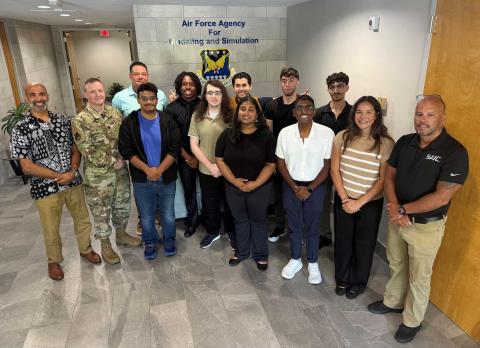Mission Need
The DOD is faced with a complex and constantly changing set of challenges and wants to leverage the best of available solutions to better prepare warfighters. Validating technology, adapting it to warfighter needs, and integrating it into missions requires more than a simple plug-and-play approach. The DOD wants to tap into the insights, passions, and technology prowess of university students. The Air Force Agency for Modeling and Simulation (AFAMS) and other DOD partners like the US Army Futures Command, Synthetic Training Environment (STE) seek ways to involve young innovators in tackling pressing problems in the world of simulation and training.
Solution

AFAMS has worked for years to create a pipeline of industry and academia to stand up a center of excellence around modeling and simulation. 2025 marked a new high in that pursuit.
By pairing students with industry partners, student efforts are informed by deep mission knowledge and hard-won insights from years of tool evaluation. During the summer of 2025, learners from the University of Central Florida and Full Sail University teamed with SAIC to deliver a series of successful efforts to advance national defense.
- Accelerating Technology Adoption: One group built a playbook on how to simplify the process for new solutions to earn authority to operate (ATO). They asked how AFAMS might capitalize on new technologies not already in use—even looking at large language models (LLMs) to write a script for an API in seconds that would have taken days otherwise.
- Efficient Use of Simulators: Students explored which learning programs could really use flight simulators to get after their mission outcomes. Some are best hands-on, and the group evaluated more than 40 lesson plans as part of the study. Student software developers even visualized simulator data for use in training blended with game engines.
- Evaluate Commercial Offerings: A group of cybersecurity students evaluated commercial XR headsets for secure remote training, a study that will inform the integration of commercial technology into DOD missions. They looked at current software and platforms for ways to integrate Heads Up Displays like Apple Vision Pro. (Learn more about SAIC’s cybersecurity expertise.)
- Leveraging Cloud: Using real-time data capture, one team of students deployed training scenarios to the Air Force’s cloud-based Training Management System. (See how SAIC delivers secure cloud solutions.)
- Creating More Realistic Simulation Environments: For STE, students are pioneering drone-based terrain capture and photogrammetric processing methods that convert real-world landscapes into usable simulation terrain—rapidly and reliably. This breakthrough capability is reshaping how warfighters train, enabling realistic environments to be created and deployed faster than ever before. (Discover how digital twins enhance simulation and modeling.)
Mission Impact
Mike Enloe, CTO for STE, shared, “These engineers are doing more than writing code—they’re rewriting what’s possible. By simplifying once-complex simulations into intuitive software solutions, they’re putting advanced capabilities directly into the hands of Soldiers. No technical teams needed. Their work is saving time, cutting costs, and directly improving mission readiness—real innovations used by units like First Army today."
James Smith, PgM, STE CFT Future Concepts and Tech Dev, Army Futures Command, added, “These consummate professionals have brought a wealth of knowledge to the STE CFT Future Concepts team. They have immediately contributed to the STE CFT mission by solving technical challenges. More importantly, they are great teammates.
AFAMS shared, “To our AMAZING UCF and Full Sail students: Thank you for everything that you've accomplished in such a short time! Your creativity, drive, and dedication are truly inspiring to our AFAMS team! We can't wait to see the incredible things you do in your unlimited futures that lie ahead for each of you.”
As of August 2025, one of the students has already accepted employment with SAIC, supporting cybersecurity for AFAMS full time, highlighting the efficacy of the talent pipeline.
